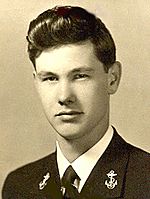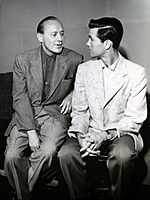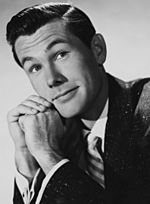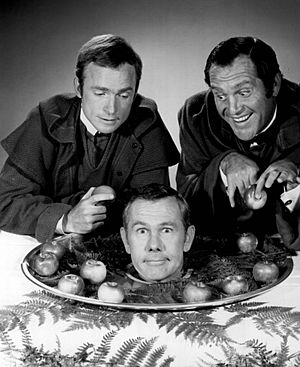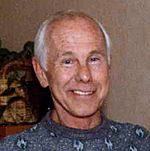Johnny Carson facts for kids
Quick facts for kids Johnny Carson |
|
|---|---|

Carson in October 1970
|
|
| Birth name | John William Carson |
| Born | October 23, 1925 Corning, Iowa, U.S. |
| Died | January 23, 2005 (aged 79) Los Angeles, California, U.S. |
| Medium | Television |
| Alma mater | University of Nebraska–Lincoln |
| Years active | 1950–1994 |
| Genres | Observational comedy, surreal humor, satire, deadpan, sketch comedy |
| Subject(s) | American culture, American politics, everyday life, pop culture, current events, human behavior, social awkwardness, gender differences |
| Spouse |
Jody Morrill Wolcott
(m. 1949; div. 1963)Joanne Copeland
(m. 1963; div. 1972)Joanna Holland
(m. 1972; div. 1985)Alexis Maas
(m. 1987) |
| Children | 3 |
| Relative(s) | Dick Carson (brother) |
| Signature |  |
John William Carson (October 23, 1925 – January 23, 2005) was an American television host, comedian, writer, and producer. He is best known as the host of The Tonight Show Starring Johnny Carson (1962–1992). Carson received six Primetime Emmy Awards, the Television Academy's 1980 Governor's Award, and a 1985 Peabody Award. He was inducted into the Television Academy Hall of Fame in 1987. Carson was awarded the Presidential Medal of Freedom in 1992 and received a Kennedy Center Honor in 1993.
During World War II, Carson served in the Navy. After the war, Carson started a career in radio. He moved from radio to TV and took over as host of the late-night talk show Tonight from Jack Paar in 1962. He remained an American icon even after his retirement in 1992. He adopted a casual, conversational approach with extensive interaction with guests, an approach pioneered by Arthur Godfrey and previous Tonight Show hosts Steve Allen and Jack Paar but enhanced by Carson's lightning-quick wit. Former late-night host and friend David Letterman, as well as many others, have cited Carson's influence. Carson is a cultural icon and widely regarded as the king of late-night television.
Contents
Early life and career
John William Carson was born on October 23, 1925, in Corning, Iowa, to Ruth Elizabeth (Hook) Carson (1901–1985) and Homer Lloyd "Kit" Carson (1899–1983), a power company manager. He was the second child of three children. He had an older sister, Catherine “Kit” (Carson) Sotzing (1923-2014) and a younger brother Richard Carson (1929-2021). As a child, he lived in the nearby towns of Avoca, Clarinda, and Red Oak in southwest Iowa before moving to Norfolk, Nebraska, at the age of eight. There, Carson grew up and began developing his talent for entertaining. At the age of 12, Carson found a book on magic at a friend's house and immediately purchased a mail-order magician's kit. After purchasing the kit, Carson practiced his entertainment skills on family members with card tricks. He was known for following his family members around saying, "Pick a card, any card." Carson's mother sewed him a cape, and his first performance was staged in front of the local Kiwanis Club. He debuted as "The Great Carsoni" at age 14 and was paid $3 a show. Soon, many other performances at local picnics and county fairs followed. After graduating from high school, Carson had his first encounter with Hollywood. He had hitchhiked to Hollywood, where he was arrested and fined $50 for impersonating a midshipman, a story often regarded as apocryphal.
Military service
Carson joined the United States Navy on June 8, 1943, and received V-12 Navy College Training Program officer training at Columbia University and Millsaps College. Commissioned an ensign late in the war, Carson was assigned to the USS Pennsylvania in the Pacific. While in the Navy, Carson posted a 10–0 amateur boxing record, with most of his bouts fought on board the Pennsylvania. He was en route to the combat zone aboard a troop ship when the war ended. Carson served as a communications officer in charge of decoding encrypted messages. He said that the high point of his military career was performing a magic trick for United States Secretary of the Navy James V. Forrestal. In a conversation with Forrestal, the Secretary asked Carson if he planned to stay in the Navy after the war. In response, Carson said no and told him he wanted to be a magician. Forrestal asked him to perform, and Carson responded with a card trick. Carson made the discovery that he could entertain and amuse someone as cranky and sophisticated as Forrestal.
Education
Taking advantage of educational opportunities from the Navy, Carson attended the University of Nebraska–Lincoln, where he joined Phi Gamma Delta fraternity and continued performing magic (then paid $25 per appearance). He majored in journalism with the intention of becoming a comedy writer, but instead switched his major to speech and drama a few months later because he wanted to become a radio performer. Carson's college thesis, titled "How to Write Comedy for Radio", was a compilation of taped skits and jokes from popular radio shows with Carson explaining the comedic technique in a voice-over. It allowed him to graduate in three years. He graduated with a Bachelor of Arts degree in radio and speech with a minor in physics in 1949.
Early radio and television
Carson began his broadcasting career in 1950 at WOW radio and television in Omaha. He soon hosted a morning television program called The Squirrel's Nest. One of his routines involved interviewing pigeons on the roof of the local courthouse that would report on the political corruption they had seen. Carson supplemented his income by serving as master of ceremonies at local church dinners—attended by some of the same politicians and civic leaders he had lampooned on the radio.
The wife of one of the Omaha political figures Carson spoofed owned stock in a radio station in Los Angeles, and in 1951 referred Carson to her brother, who was influential in the emerging television market in Southern California. Carson joined CBS-owned Los Angeles television station KNXT (now KCBS-TV). In 1953, comic Red Skelton—a fan of Carson's "cult success" low-budget sketch comedy show, Carson's Cellar (1951 to 1953) on KNXT—asked Carson to join his show as a writer. In 1954, Skelton accidentally knocked himself unconscious during rehearsal, an hour before his live show began. Carson successfully filled in for him. In 1955, Jack Benny invited Carson to appear on one of his programs during the opening and closing segments. Carson imitated Benny and claimed that Benny had copied his gestures. Benny predicted that Carson, who readily admitted Benny's substantial influence on aspects of his comedic delivery, would have a successful career as a comedian.
Carson hosted several shows besides Carson's Cellar, including the game show Earn Your Vacation (1954) and the CBS variety show The Johnny Carson Show (1955–1956). He was a guest panelist on the original To Tell the Truth beginning in 1960, becoming a regular panelist from 1961 to 1962. After the primetime The Johnny Carson Show failed, he moved to New York City to host ABC-TV's Who Do You Trust? (1957–1962). It was on Who Do You Trust? that Carson met his future sidekick and straight man, Ed McMahon. Although he believed moving to daytime television would hurt his career, Who Do You Trust? was a success. It was the first show where he could ad lib and interview guests, and because of Carson's on-camera wit, the show became "the hottest item on daytime television" during his six years at ABC. From his experience as a radio host, he would later write a parody for New Yorker Magazine of former talk show host Dennis Miller having the new role at the time (2000) as an NFL sports announcer, titled "Proverbs of Dennis Miller".
The Tonight Show
NBC's Tonight was the late-night counterpart to its early-morning show Today. Originating in 1954 with host Steve Allen, Tonight was somewhat experimental at the time, as the only previous network late-night program was NBC's Broadway Open House which starred Jerry Lester and Dagmar. Tonight was successful, and when Allen moved on to primetime comedy-variety shows in 1957, Jack Paar replaced him as host of Tonight. Paar left the show in 1962.
Carson's success on ABC's Who Do You Trust? led NBC to invite him to take over Tonight a few months before Paar's departure. Carson declined the offer because he feared the difficulty of interviewing celebrities for 105 minutes each day. Bob Newhart, Jackie Gleason, Groucho Marx, and Joey Bishop all also declined. NBC finally convinced Carson to sign by early February 1962. Carson can be seen discussing his upcoming job for the first time on the February 11, 1962, episode of What's My Line?. Due to Carson having six months left on his ABC contract, NBC used multiple guest hosts until he could take over. Guest hosts included Merv Griffin, Art Linkletter, Joey Bishop, Arlene Francis (the first woman to host The Tonight Show), Bob Cummings, Jerry Lewis, Groucho Marx, Donald O'Connor, and others.
Although he continued to have doubts about his new job, Carson became the host of Tonight (later called The Tonight Show Starring Johnny Carson) on October 1, 1962. After a difficult first year, he overcame his fears. While Tonight under its previous hosts had been successful, especially under Paar, Carson's version eventually did very well in the ratings.
McMahon followed Carson from Who Do You Trust? as his announcer and sidekick, and Skitch Henderson was installed as the maestro of the NBC orchestra. McMahon's famous introduction, "Heeeeere's Johnny!!!" was followed by a brief monologue by Carson. This was often followed by comedy sketches, interviews, and music. Carson's trademark was a phantom golf swing at the end of his monologues, aimed stage left toward the studio orchestra. (Guest hosts sometimes parodied that gesture. Bob Newhart rolled an imaginary bowling ball toward the audience.)
Paul Anka wrote the theme song, ("Johnny's Theme"), a reworking of his "Toot Sweet"; given lyrics, it was renamed "It's Really Love" and recorded by Annette Funicello in 1959. Before taking over The Tonight Show, Carson wrote lyrics for the song, and so claimed 50 percent of the song's performance royalties (though the lyrics were never used). The theme is heard being played on sound recordings of Carson's first Tonight Show, and it was used without interruption through to his last broadcast on May 22, 1992.
The show was originally produced at the 30 Rockefeller Plaza NBC television studios in New York City, with occasional stints in California. The program began videotaping in advance during the Jack Paar days, although during the 1970s, NBC fed the live taping from Burbank to New York via satellite for editing (see below). Carson had a talent for quick quips to deal with problems. If the opening monologue fared poorly, the band would start playing "Tea for Two" and Carson danced a softshoe to laughs from the studio audience. Alternatively, Carson might pull the boom microphone close to his face and announce, "Attention K-Mart shoppers, clean up in aisle four!"
Move to Burbank
On May 1, 1972, the show moved from 30 Rockefeller Plaza to Burbank, California, because of the studio's proximity to celebrities.
From July 1971, Carson stopped hosting five shows per week. Instead, Mondays featured a guest host, leaving Carson to host the other four weeknights. Shows were videotaped in Burbank at 5:30 pm, fed from there to the Central and Eastern time zone stations via cross-country television line at 8:30 pm Pacific time (11:30 pm Eastern time), and later sent from Burbank to the Pacific time zone stations at 11:30 pm Pacific time. Since only two feeds originated from Burbank, Central time zone stations received the Eastern feed one hour earlier at 10:30 pm local time, and Mountain time stations received the Pacific time zone feed one hour later at 12:30 am local time.
In 1980, at Carson's request, the show cut its 90-minute format to 60 minutes on September 16; Tom Snyder's Tomorrow added a half-hour to fill the vacant time. Joan Rivers became the "permanent" guest host from September 1983 until 1986. The Tonight Show then returned to using rotating guest hosts, including comic George Carlin. Jay Leno became the exclusive guest host in fall 1987. Leno joked that although other guest hosts had upped their fees, he had kept his low, assuring himself more bookings. Eventually, Monday night was for Leno, Tuesday for The Best of Carson—rebroadcasts usually dating from a year earlier, but occasionally from the 1970s.
Although Carson's work schedule became more abbreviated, Tonight remained so successful that his compensation from NBC continued to rise; by the mid-1970s, he had become the highest-paid personality on television, earning about $4 million a year ($17,947,000 today), not including nightclub appearances and his other businesses. He refused many offers to appear in films, including title roles in The Thomas Crown Affair and Gene Wilder's role in Blazing Saddles. He also declined director Martin Scorsese's offer to co-star with Robert De Niro in the 1983 film The King of Comedy, with the role of a TV talk-show host then going to Jerry Lewis.
In recognition of his 25th anniversary on The Tonight Show, Carson received a personal Peabody Award, the board saying he had "become an American institution, a household word, [and] the most widely quoted American." They also said they "felt the time had come to recognize the contributions that Johnny has made to television, to humor, and to America."
Uri Geller
In 1973, magician, television personality, and self-proclaimed psychic Uri Geller appeared on The Tonight Show. In the NOVA documentary, James Randi – Secrets of the Psychics, magician and skeptical activist James Randi says that Carson "had been a magician himself and was skeptical" of Geller's claimed paranormal powers, so, prior to the date of taping, Randi was asked "to help prevent any trickery." Per Randi's advice, the show prepared their own props without informing Geller, and did not let Geller or his staff "anywhere near them." When Geller joined Carson on stage, he appeared surprised that he was not going to be interviewed, but instead was expected to display his abilities using the provided articles. Geller said "This scares me." and "I'm surprised because before this program your producer came and he read me at least 40 questions you were going to ask me." Geller was unable to display any paranormal abilities, saying "I don't feel strong" and he expressed his displeasure at feeling like he was being "pressed" to perform by Carson.
However, ironically, this appearance on The Tonight Show, which Carson and Randi had orchestrated to debunk Geller's claimed abilities, backfired.
Comic characters
Carson played several continuing characters on sketches during the show, including:
- Art Fern was the "Tea Time Movie" announcer, whose theme song was "Hooray for Hollywood". Carson once admitted on camera that this was his favorite character, based on late-afternoon TV hosts who would deliver commercials throughout the movie. Each sketch usually featured three long commercials interrupted by silent, four-second clips from antique films. When the camera returned from each clip, Art was always caught off-guard and immediately reminded viewers that they were watching a film favorite. The movies always had unlikely casts and even less likely titles: "Slim Pickens, Patti Page, 'Duke' John Wayne, and Charlton Heston in another classic Western: 'Kiss My Saddle Horn'!" Carson originally played the fast-talking huckster in his own voice (as Honest Bernie Schlock or Ralph Willie), and finally settled on a nasal, high-pitched, smarmy drone, reminiscent of Jackie Gleason's "Reginald Van Gleason III" character. The character, now permanently known as Art Fern, wore a lavish toupee, loud jackets, and a pencil mustache. Actress Carol Wayne became famous for her 100-plus appearances (1971–1984) as Art's assistant, the Matinée Lady. While Art gave his spiel, she would enter the stage behind him. After Carol Wayne's death in 1985, Carson kept Art Fern off the air for most of the next year, and finally hired Danuta Wesley and then Teresa Ganzel to play the Matinée Lady. Carson also used these sketches to poke fun at the intricate Los Angeles interstate system, using a pointer and map to give confusing directions to shoppers, often including points where he would unfold the cardboard map to point out, via the appropriate picture, when the shopper would arrive at "the fork in the road". Another freeway routine in the same theme centered on the "Slauson Cutoff", a slang term Carson popularized to describe the truncated Marina Freeway (which ended abruptly at Slauson Avenue in Culver City). Art Fern would advise drivers to take a series of freeways until they reached the Slauson Cutoff, and would then advise them to "Get out of your car, cut off your slauson, get back in your car," often followed by peals of laughter from the audience, led by McMahon.
- Carnac the Magnificent, a turbaned psychic, could answer questions before seeing them. Carnac had a trademark entrance in which he always turned the wrong direction when coming onstage and then tripped on the step up to Carson's desk. (In one episode, technicians rigged Carson's desk to fall apart when Carnac fell into it.) These comedic missteps were an indication of Carnac's true prescient abilities. McMahon would hand Carson a series of envelopes containing questions, said to have been "hermetically sealed and kept in a mayonnaise jar on Funk & Wagnalls' porch since noon today." Carson would place each envelope against his forehead and predict the answer, such as "Gatorade". Then, he would read the question: "What does an alligator get on welfare?" Some of the jokes were feeble, and McMahon used pauses after terrible puns and audience groans to make light of Carson's lack of comic success ("Carnac must be used to quiet surroundings"), prompting Carson to return an equal insult. Pat McCormick wrote some of the zaniest Carnac material. The one that had McMahon and Carson nearly rolling on the floor with sustained laughter was "Sis boom bah". Answer – "Describe the sound made when a sheep explodes." McMahon would always announce near the end, "I hold in my hand the last envelope," at which the audience would applaud wildly, prompting Carnac to pronounce a comedic "curse" on the audience, such as "May a flock of wild geese leave a deposit on your breakfast!", "May your sister elope with a camel!", "May a diseased yak take a liking to your sister", or the most famous: "May the bird of paradise fly up your nose!" The character was taken from Steve Allen's essentially identical "Answer Man" segment, which Allen performed during his tenure as host of The Tonight Show in the 1950s. As Allen acknowledged in his book The Question Man, this bit had been created in Kansas City in 1951 by Bob Arbogast and used on The Tom Poston Show in New York where it eventually ended up on The Steve Allen Show, much to the surprise of both Bob and Steve. The Carnac character and routine also closely resemble Ernie Kovacs' "Mr. Question Man".
- Floyd R. Turbo American (with no pause between words) was a stereotypical common working man, wearing a plaid hunting coat and cap, who offered "editorial responses" to left-leaning causes or news events. Railing against women's rights in the workplace, for example, Turbo would shout: "This raises the question: kiss my Dictaphone!"
- Aunt Blabby, a cantankerous and sometimes amorous old lady, was invariably interviewed by straight man Ed McMahon about elder affairs. McMahon would innocently use a common expression like "check out", only to have Aunt Blabby warn him: "Don't say 'check out' to an old person!" Aunt Blabby was an obvious copy of Jonathan Winters' most famous creation, Maude Frickert, including her black spinster dress and wig.
- El Mouldo, a mentalist, would attempt to perform mind-reading and mind-over-matter feats, all of which failed. Often, his tricks would include an attempt to bilk money from Ed McMahon or would end with his begging the audience for a dollar, or at least bus fare.
- The Maharishi, whose theme song was "Song of India", was a frizzy-haired "holy man" who spoke in a high-pitched, tranquil tone, greeted announcer McMahon with a flower, and answered philosophical questions. This was a take-off on Maharishi Mahesh Yogi.
Carson uncensored on satellite
Although Carson's program moved to Burbank in 1972, NBC's editing and production services for the show remained in New York, requiring that the program be transmitted between the two cities. In 1976, NBC used the Satcom 2 satellite to achieve this, feeding the live taping (which started around 5:30 pm local time) directly to New York, where it would be edited prior to the late-night broadcast. This live feed lasted usually for two to two-and-a-half hours a night and was both uncensored and commercial-free. During the slots for commercial breaks, the audio and picture feed would continue, capturing events that would be edited out before transmission.
At the same time, satellite ground stations owned by individuals began appearing, and some found the live feed. Satellite dish owners began to document their sightings in technical journals, giving viewers knowledge of things they were not meant to see. Carson and his production staff grew concerned about this and pressured NBC into ceasing the satellite transmissions of the live taping in the early 1980s. The satellite link was replaced by microwave transmission until the show's editing facilities were moved to Burbank.
Business ventures
Carson invested $500,000 in the DeLorean Motor Company. Additionally, Carson was head of a group of investors who purchased and operated two television stations. The first was KVVU-TV in Henderson, Nevada, an independent station serving Las Vegas, acquired by the Carson group in 1979. Shortly after buying the station, KVVU was rumored to be acquiring an NBC affiliation as then long-time affiliate KORK-TV was in the process of being replaced by KVBC (and now KSNV), but it never happened. Carson's second station, independent KNAT-TV in Albuquerque, New Mexico, was purchased in 1982. Unlike the Las Vegas operation, KNAT faced stiffer competition for top-quality, syndicated programming. Carson sold both of his stations in 1985 and 1986 with KVVU-TV (FOX 5) going to the Meredith Corporation and KNAT being sold to Trinity Broadcasting Network.
Carson's other business ventures included the successful Johnny Carson Apparel, Inc.—his turtlenecks became a fashion trend—and a failed restaurant franchise.
Retirement
Carson retired from show business on May 22, 1992, at age 66, when he stepped down as host of The Tonight Show. His farewell was a major media event, often emotional for Carson, his colleagues, and the audiences, and stretched over several nights. In tribute to Carson and his enormous influence, several networks that had late-night variety talk shows "went dark" for the entire hour he did the last show. After 13 tries, The Tonight Show finally won the Emmy for Outstanding Late-night later that year, buoyed by the penultimate broadcast, which featured Johnny's final two guests: Robin Williams and Bette Midler.
NBC gave the role of host to the show's then-current permanent guest host, Jay Leno. Leno and David Letterman were soon competing on separate networks.
Post-retirement appearances
At the end of his final Tonight Show episode, Carson indicated that he might, if so inspired, return with a new project. Instead, he chose to go into full retirement, rarely giving interviews and declining to participate in NBC's 75th-anniversary celebrations. He made an occasional cameo appearance, including voicing himself on the May 13, 1993, episode of The Simpsons ("Krusty Gets Kancelled"), telephoning David Letterman on a November 1993 episode of Late Show with David Letterman, and appearing in the 1993 NBC special Bob Hope: The First 90 Years.
On May 13, 1994, Carson appeared on the Late Show with David Letterman. During a week of shows from Los Angeles, Letterman was having Larry "Bud" Melman (Calvert DeForest) deliver his "Top Ten Lists" under the guise that a famous personality would be delivering the list, instead. On the last show of the week, Letterman indicated that Carson would be delivering the list. Instead, DeForest delivered the list, insulted the audience (in keeping with the gag), and walked off to polite applause. Letterman then indicated that the card he was given did not have the proper list on it and asked that the "real" list be brought out. On that cue, the real Carson emerged from behind the curtain (as Letterman's band played "Johnny's Theme"), an appearance that prompted a 90-second standing ovation from the audience. Carson then asked to sit behind Letterman's desk; Letterman obliged, as the audience continued to cheer and applaud. After some moments, Carson departed from the show without having spoken to the audience. He later cited acute laryngitis as the reason for his silence. This turned out to be Carson's last television appearance.
Carson also reviewed clips of the Tonight Show included in DVD compilations, and had humor pieces published in The New Yorker.
Letterman
Prior to his death, Carson occasionally sent jokes to David Letterman. Letterman would then use these jokes in the monologue of his show, which Carson got "a big kick out of", according to Worldwide Pants Inc. senior vice president Peter Lassally, who formerly produced both men's programs. He also said Carson had always believed Letterman, not Leno, to be his "rightful successor". In his first broadcast after Carson's death, Letterman delivered a monologue compiled entirely of jokes sent in by Carson, a fact the host revealed a short time later in the program.
Influences
Carson's influences included Jack Benny, Red Skelton, Fred Allen, Bob Hope, Groucho Marx, and Jack Paar.
Legacy and impact on popular culture
Carson's show launched the careers of many performers, especially comedians and musicians. For a comedian appearing on the show, getting Carson to laugh and being invited to the guest chair were considered the highest honors. Notable among these were David Letterman, Robin Williams, Jay Leno, Jerry Seinfeld, Arsenio Hall, Jeff Foxworthy, Ellen DeGeneres, Rodney Dangerfield, Joan Rivers, David Brenner, Tim Allen, Drew Carey, Howie Mandel, Roseanne Barr and Don Rickles. Carson was successor to The Ed Sullivan Show as a showcase for different types of talent, as well as continuing a vaudeville-style variety show.
In 1966, Carson popularized Milton Bradley's game Twister when he played it with actress Eva Gabor. Not widely known up to that time, the game skyrocketed in popularity after the broadcast.
Comedians who credit Carson as an influence include David Letterman, Jay Leno, Conan O'Brien, Dennis Miller, Bill Maher, Joan Rivers, Larry Wilmore, Ray Romano, Don Rickles, Bob Newhart, Angie Dickinson, Carl Reiner, Mel Brooks, Dick Cavett, Norm Macdonald, David Steinberg, Jerry Seinfeld, Ellen DeGeneres, Garry Shandling, Steve Martin, Ray Combs, Arsenio Hall, Craig Ferguson, Orson Bean, and Jimmy Fallon.
Brian Wilson was an avid fan of the show and in 1977 wrote a song titled "Johnny Carson" as a tribute. It was released on the Beach Boys Love You album.
Personal life
Despite his on-camera demeanor, Carson was introverted and shy off-camera. He was known for avoiding most large parties and was referred to as "the most private public man who ever lived." Dick Cavett recalled, "I felt sorry for Johnny in that he was so socially uncomfortable. I've hardly ever met anybody who had as hard a time as he did." In addition, George Axelrod once said of Carson, "Socially, he doesn't exist. The reason is that there are no television cameras in living rooms. If human beings had little red lights in the middle of their foreheads, Carson would be the greatest conversationalist on Earth."
He normally refused to discuss politics, social controversies, his childhood, or his private life with interviewers, and offered a list of written answers to journalists who wanted to ask him questions. Among them were "Yes, I did," "No, I didn't," and "No. Kumquats."
Politics
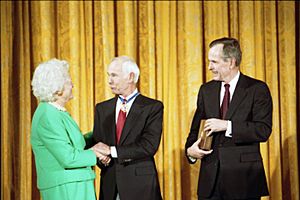
Carson opposed the Vietnam War and capital punishment, and favored racial equality. He avoided explicitly mentioning his views on The Tonight Show, saying he "hates to be pinned down" as that would "hurt me as an entertainer, which is what I am." He also seldom invited political figures onto the Tonight Show because he "didn't want it to become a political forum" and did not want the show used, by himself or others, to influence the opinions of the viewers.
In his book, Carson's former lawyer Henry Bushkin stated, he "was by instinct and upbringing definitely Republican, but of an Eisenhower sort that we don't see much of anymore ... Overall, you'd have to say he was anti-big: anti-big government, anti-big money, anti-big bullies, anti-big blowhards." Carson served as MC for Ronald Reagan's inaugural gala in 1981 at the request of Frank Sinatra.
Religion
As an adult, Carson was not a regular churchgoer, although during his childhood he was raised as a Methodist and during high school attended Christian Endeavor meetings at the local church.
Marriages
In October 1949, Carson married Jody Wolcott in North Platte, Nebraska. The marriage was volatile, with infidelities committed by both parties, and ended in divorce in 1963.
Carson married Joanne Copeland the same year, on August 17. After a second protracted divorce in 1972, Copeland received a settlement of $6,000 per month in alimony until she remarried or until Carson's death (she received it until his death in 2005). She also received "a pretty nice little art collection." She later had a second marriage that also ended in divorce, and died in California, aged 83, in 2015. She had no children.
At the Carson Tonight Show's 10th-anniversary party on September 30, 1972, Carson announced that former model Joanna Holland and he had been secretly married that afternoon, shocking his friends and associates. On March 8, 1983, Holland filed for divorce. The divorce case finally ended in 1985 with an 80-page settlement, with Holland receiving $20 million in cash and property.
On June 20, 1987, Carson married Alexis Maas. The marriage lasted until his death in 2005.
Carson reportedly joked, "My giving advice on marriage is like the captain of the Titanic giving lessons on navigation."
Children
Carson had three sons with his first wife: Christopher, Cory, and Richard. His middle son, Richard, died on June 21, 1991, when his car plunged down a steep embankment along a paved service road off Highway 1 near Cayucos, California. Apparently, Richard had been taking photographs when the accident occurred. On the first Tonight Show after his son's death, Carson paid tribute to Richard's photographic work by showing his nature slides, while Stevie Ray Vaughan's 1989 song "Riviera Paradise" played in the background. In addition, the final image of the show, as well as some "More to Come" bumpers, of Carson's last show on May 22, 1992, featured a photo Richard had taken.
Philanthropy
In 1981, Carson created the John W. Carson Foundation, dedicated to supporting children, education, and health services. In August 2010, the charitable foundation created by Carson reported receiving $156 million (equivalent to $233,747,487 in 2022) from a personal trust established by the entertainer years prior to his January 2005 death. Carson's foundation was now by far the largest of the Hollywood charities. The foundation continues to support charitable causes.
In November 2004, Carson announced a $5.3 million gift to the University of Nebraska Foundation to support the Hixson–Lied College of Fine and Performing Arts Department of Theater Arts, which created the Johnny Carson School of Theater and Film. Another $5 million donation was announced by the estate of Carson to the University of Nebraska following his death, while a $1 million donation was announced on November 4, 2011, creating the Johnny Carson Opportunity Scholarship Fund. The foundation made another $5 million donation to the university on October 22, 2021 to augment the Opportunity Scholarship Fund.
Carson also donated to causes in his hometown of Norfolk, including the Carson Cancer Center at Faith Regional Health Services, the Elkhorn Valley Museum, and the Johnny Carson Theater at Norfolk Senior High School. Carson also donated to the Northeast Community College Lifelong Learning Center in honor of his favorite teacher, Miss Faye Gordon. Miss Gordon had appeared on his show a number of times. His last known visit to Norfolk was to throw the 100th-birthday party for Miss Gordon, which Carson had promised to do several years earlier.
Other interests
Carson, an amateur astronomer, was a close friend of astronomer Carl Sagan, who often appeared on The Tonight Show. The unique way Sagan had of saying certain words, like "billions" of stars, would lead Carson to ribbing his friend, saying "BILL-ions and BILL-ions". Carson was the first person to contact Sagan's wife Ann Druyan with condolences when the scientist died in 1996. He owned several telescopes, including a top-of-the-line unit. In 1981, the minor planet 1981 EM4 was named in his honor, 3252 Johnny. That year, a star was also nicknamed after Carson.
Carson was an amateur drummer and was shown on a 1979 segment of 60 Minutes practising at home on a drum set given to him by his close friend Buddy Rich, who was the jazz musician with the most appearances on The Tonight Show. Gore Vidal, another frequent Tonight Show guest and friend, wrote about Carson's personality in his 2006 memoir.
Carson was an avid tennis player. When he sold a Malibu house to John McEnroe and Tatum O'Neal, the escrow terms required McEnroe to give Johnny six tennis lessons. Carson's primary tennis teacher was Bob Trapenberg, who taught him for some time, and traveled with him to Wimbledon.
Death and tributes
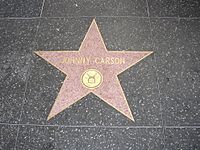
On March 19, 1999, Carson suffered a severe heart attack at his home in Malibu, California, and was hospitalized in nearby Santa Monica, where he underwent quadruple-bypass surgery.
Carson had been a heavy smoker for decades, and in the early days of his tenure on The Tonight Show, often smoked on-camera.
At 6:50 am PST on January 23, 2005, Carson died at Cedars-Sinai Medical Center in Los Angeles of respiratory failure arising from emphysema. He was 79, and had revealed his terminal illness to the public in September 2002. His body was cremated, and the ashes were given to his wife, Alexis Maas. In accordance with his family's wishes, no public memorial service was held. Carson was also survived by his younger brother, Dick, who was an Emmy Award-winning director of, among other things, the competing Merv Griffin Show and Wheel of Fortune.
Numerous tributes were paid to Carson upon his death, including a statement by then-President George W. Bush, all recognizing the deep and enduring affection held for him.
On January 31, The Late Show with David Letterman paid tribute with former Tonight Show executive producer Peter Lassally and bandleader Doc Severinsen. At the beginning of this show, Letterman said that for 30 years, no matter what was going on in the world, whether people had a good or bad day, they wanted to end it being "tucked in by Johnny." He also told his viewers that the monologue he had just spoken, which was very well received by the studio audience, consisted entirely of jokes sent to him by Carson in the last few months of his life. Doc Severinsen ended the Letterman show that night by conducting and playing, along with Tommy Newsom and Ed Shaughnessy, one of Carson's two favorite songs, "Here's That Rainy Day" (the other was "I'll Be Seeing You"). The Tonight Show with Jay Leno also paid tribute to Carson with guests Ed McMahon, Bob Newhart, Don Rickles, Drew Carey, and k.d. lang.
On his final Tonight Show appearance, Carson himself said that while sometimes people who work together for long stretches of time on television do not necessarily like each other, this was not the case with McMahon; he and McMahon were good friends who would have drinks and dinner together, and the camaraderie they had on the show could not be faked. Their friendship spanned 46 years.
The 2005 film The Aristocrats was dedicated to Carson.
The Simpsons, season 16, episode seven, "Mommie Beerest", was dedicated to his memory.
At the first Comedy Awards on Comedy Central, the Johnny Carson Award was given to David Letterman. At the 2nd Annual Comedy Awards on Comedy Central, the Johnny Carson Award was given to Don Rickles.
A two-hour documentary about his life, Johnny Carson: King of Late Night, aired on PBS on May 14, 2012, as part of their American Masters series. It is narrated by Kevin Spacey and features interviews with many of Carson's family, fellow comedians, and protégés.
A park is named in his honor in Burbank, across from the former NBC Studios.
See also
 In Spanish: Johnny Carson para niños
In Spanish: Johnny Carson para niños


